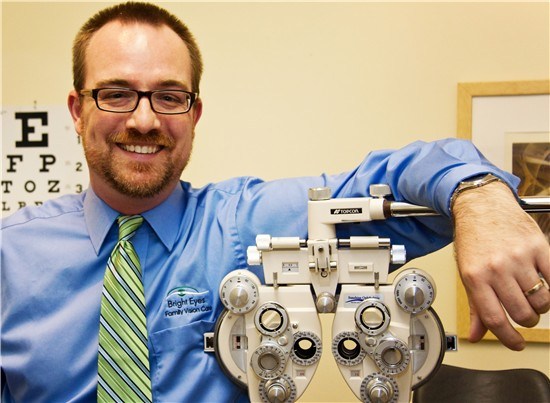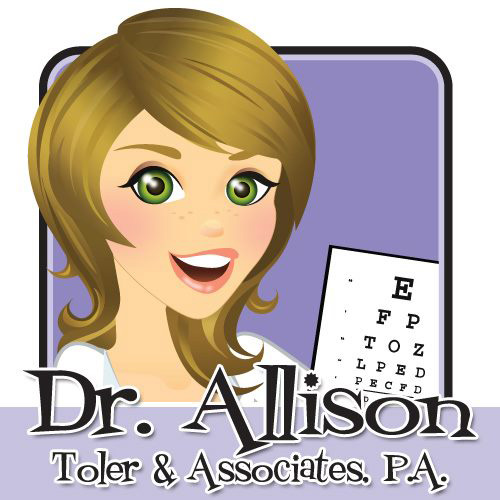By Nathan Bonilla-Warford, OD

When was the last time you saw a business card that was truly memorable? When was the last time you saw an optometric practice with a logo that really stuck out in your mind? Creating an effective brand identity is one of the most important tasks facing any practice. The practice brand must effectively establish your credibility as a doctor, connect emotionally with patients, and create loyalty. So why do so many optometry logos (mine included) fail to truly excite interest? Well, we could all learn from Allison Toler, OD, of Dr. Allison Toler & Associates, Super Target Optical, in Clermont, Fla., who hit a homerun with a branding strategy that is nothing short of brilliant.
Allison Toler, OD, of Dr. Allison Toler & Associates, Super Target Optical, in Clermont, Fla., hired an illustrator to create the above image. She uses the image as branding across all channels of communication.
According to the American Marketing Association, a brand is a “Name, term, design, symbol, or any other feature that identifies one seller’s good or service as distinct from those of other sellers.” While this definition is sturdy and accurate, I prefer Seth Godin’s: “A brand is the set of expectations, memories, stories and relationships that, taken together, account for a consumer’s decision to choose one product or service over another.” This more effectively accounts for why branding works–because of the relationship that is created between the optometrist and the patient.
Recently I was attending a weekend study group, when I was struck by Dr. Toler’s logo on her business card. Not only is it fun and engaging, but it is perfectly consistent: from business cards, web site, social strategies, and even her car! This is especially impressive considering that she practices in a retail environment where most ODs make little effort to develop a strong, distinct brand.
I was happy that Dr. Toler was willing to share some thoughts of her process with the readers of Review of Optometric Business, as I think we could all learn from her. I know I did. Because her professional-yet-fun cartoon logo was so interesting, I started by asking her about that.
Dr. Bonilla-Warford: What process did you use to come up with your logo?
Dr. Toler: Before any logo design began, it was important to develop both a branding strategy and objectives to direct marketing efforts. From the beginning, the goal was to differentiate our practice from both Target Optical and the previous optometrists who occupied the lease. It was essential to retain and capitalize on the existing Target customer base, primarily middle-aged females with children. If our existing market trusted us with their children, they would trust us with their spouses, friends and family. Therefore, our branding strategy and marketing plan had to be both kid friendly and memorable.
My husband, a marketing MBA and partner in the practice, bounced around ideas for a mascot. A cartoon character was perfect. We decided on a retro “Jetsons” style cartoon character that resembled me. We hired an illustrator to create the cartoon at a cost of only $200. The process went smoothly but required several redraws on the hair. I guess it’s a girl thing. The cartoon creation in lieu of a traditional portrait photo or logo with an eye is, well, eye-catching.
Finally, we chose a purple color scheme to contrast Target red. The purple “pops” in a sea of red and is considered a “girl” color. A retro font reminiscent of the “Jetsons” era was selected to give our overall brand a fun look. If kids think I’m fun, my eye exam will be too.
Dr. Bonilla-Warford: How do you see your logo fit within your overall branding?
Dr. Toler: The branding illustrates I am a young, female eye doctor with children who can relate to moms and kids. All of our marketing materials have the same standardized look with a message appropriate to the context. The cartoon caricature takes up 50+ percent of the ad space. Branding creates awareness that the eye doctor inside Super Target Optical, Clermont, FL, is kid friendly.
Dr. Bonilla-Warford: What channels do you use to promote your practice?
Dr. Toler: Families with young children are our primary target market, so it makes sense to promote our practice through channels that communicate with this market:
• Store Signs: Moms love Target. The first and most obvious example is to promote the practice to patrons of Clermont Super Target. Upon entering Target, the first thing you see is the coupon display window with an 8.5” x 11” letter-size display ad promoting the practice. We also have a 5.5’ x 2.5’ life-size cartoon illustration sign outside the optical that can be seen from both entrances. Again, all of our marketing materials feature the cartoon illustration on 50+ percent of the available ad space, the same retro font and purple color scheme. All marketing pieces must be visual.
• Vision Screenings: We offer vision screenings to private schools and community events in our area throughout the year. These events offer the opportunity to showcase our brand. My husband attends these events while I have office hours. A portable pop-up sign identical to the 5.5’ x 2.5’ life-size cartoon illustration is featured at these screenings. Kids around town now recognize the life-size poster because they saw it at Target or school.
• Traditional Marketing: Target Optical provides patient recall via postcards and e-mail as part of our lease agreement. These are standardized and do not offer the opportunity to customize. We appreciate the resource, but turn our efforts to local marketing channels. Spending more does not necessarily mean a bigger return. In fact, we prefer a variety of small local marketing outlets focused on children. This quarter we did the following:
• 5,000 postcard distribution with our local Chick-fil-A
• Monthly mailings to other local physicians
• Follow-up fax with patient treatment information to referring physicians
• Flyers to businesses that have vision plans we accept
• Supply donations to local schools
• Offer free exam certificates to community fundraisers
I was curious if Dr. Toler thought that this kind of strong branding was a growing trend for other ODs in retail settings. She said that she didn’t know of others who had marketed themselves like she has. She speculated that most retail-leasing ODs are reluctant to spend the money on marketing because they feel the marketing of the host location is sufficient.
If you are a doctor leasing space from a retail chain, check your lease before undertaking any large branding efforts. Additionally, if you have a contract, you should discuss your plans with your employer. I have talked to retail-leasing ODs who have had both good and bad experiences branding themselves.
For all optometrists, regardless of mode of practice, when was the last time you really took a look at your branding efforts? As competition heats up, your brand will be even more important. Is your logo getting the reaction you want? Does your practice name reflect the brand you are trying to build? I know there are some things I’d like to change.
Nathan Bonilla-Warford, OD,of Bright Eyes Family Vision Care in Tampa, Fla., is a graduate of Illinois College of Optometry. He is a member of the American Optometric Association, and is past president of the Hillsborough Society of Optometry, as well as chair of the Children’s Vision Committee of the Florida Optometric Association. To contact him: Doc@BrightEyesTampa.com.






















